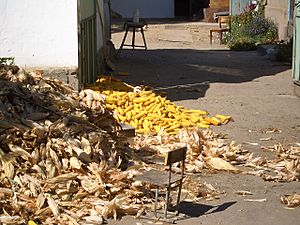Husk facts for kids
A husk (also called a hull) is the outer layer or covering of a seed, fruit, or vegetable. Think of it like a natural protective wrapper! For example, the leafy outer covering of an ear of maize (corn) is called a husk. Sometimes, the word "husk" can also mean the skin that insects or other small animals leave behind when they shed their old skin.
In cooking, a hull can also mean other parts of fruits and vegetables that we don't usually eat. A good example is the small green cap or sepal on top of a strawberry. The husk of a legume, like a pea or bean, is often called a pod.
Removing Husks and Hulls

Removing the outer layers from corn is called husking. This process leaves only the cob or the part of the corn that holds the kernels.
Dehulling is the process of taking off the hulls or outer coverings from beans and other seeds. This is often done using a special machine called a huller.
Why We Remove Hulls
Before oils can be taken out of seeds, they need to be cleaned. First, any dirt or other objects are removed. Then, their hulls or outer coverings are taken off. This step is important for getting the best quality oil.
How Hulls Are Removed
While machines often do this work today, in many parts of the world, husking and dehulling are still done by hand. People often use a large mortar and pestle, which are usually made of wood. One or more people work together to remove the husks this way.
What Happens to Husks
Husks are biodegradable, meaning they can break down naturally over time. Because of this, they can often be added to a compost pile. Composting turns them into rich soil for plants.
fr:Son (botanique)

